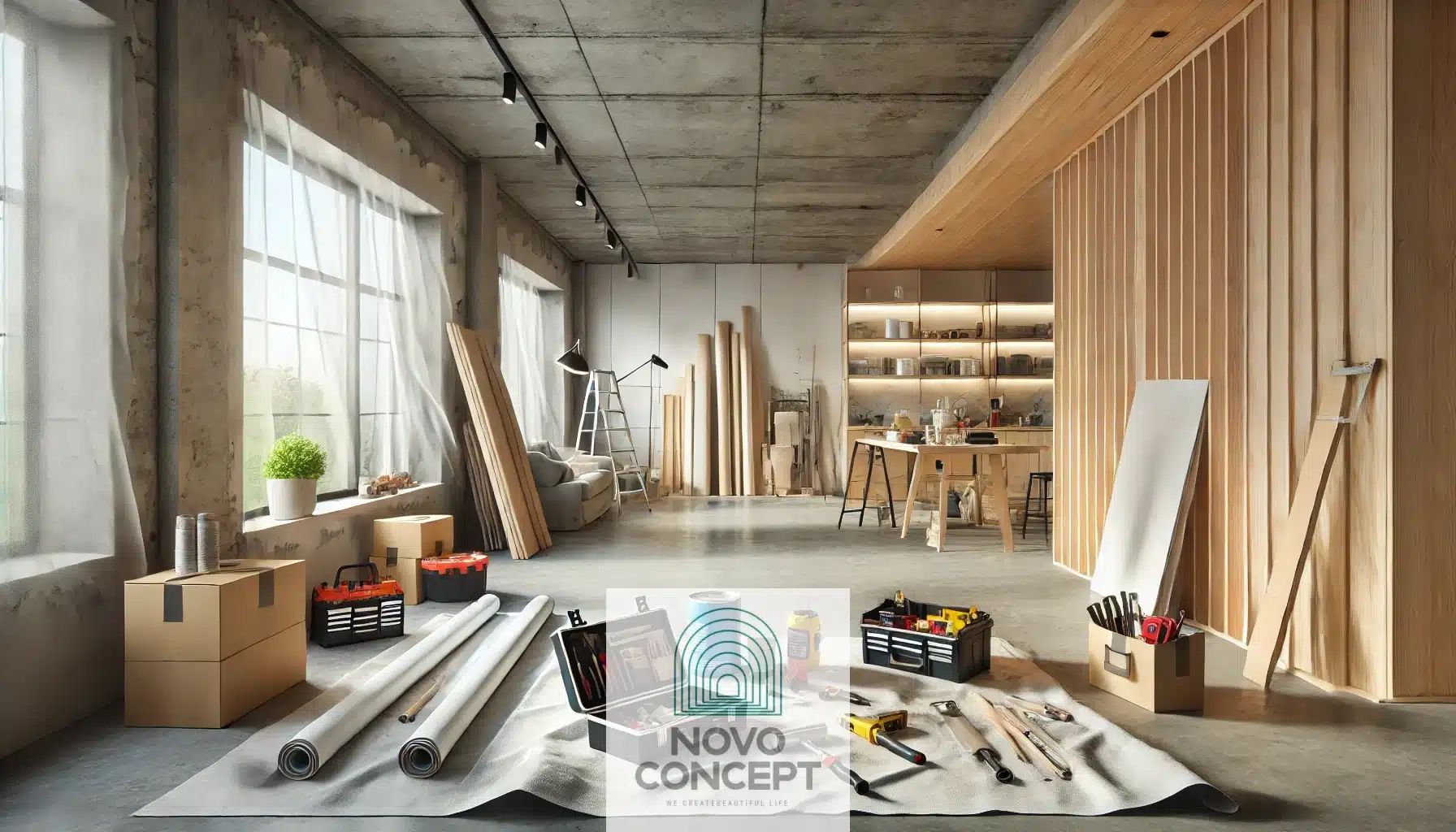If you’re considering a basement remodel, preparation is the key to a smooth and successful renovation process. Taking the time to organize and plan can save you from unexpected challenges and ensure the outcome meets your expectations. Here is a detailed guide from Novo Concept with actionable steps to get your basement ready for its transformation:
Step One: Clear Out the Basement
Start by removing all furniture, belongings, and clutter from the basement. A clean and empty space will not only streamline the renovation process but also make it easier for contractors to access and work in the area.
Tips for clearing out:
- Create a checklist to ensure nothing is left behind.
- Label boxes and bins for items you plan to store or relocate.
- Consider donating or discarding items you no longer need to reduce clutter.
Step Two: Create a Temporary Storage Space
After clearing out your basement, identify a safe place to store the items temporarily. Whether it’s another room, a storage unit, or your garage, ensure the storage area is organized and accessible.
Pro tips for effective storage:
- Place frequently used items in easily reachable spots.
- Use plastic bins with tight-fitting lids to protect against dust and moisture.
- Avoid stacking heavy items on fragile ones to prevent damage.
Step Three: Protect Immovable Valuables
For items that cannot be removed from the basement, take measures to shield them from potential damage during the remodel. Dust, debris, and accidental impacts can harm valuable items if left exposed.
Protective measures include:
- Covering items with thick tarps or padded blankets.
- Moving items to the farthest corner away from construction activity.
- Using plastic sheeting to create temporary barriers.
Step Four: Disconnect Utilities Safely
Most basement remodels involve some degree of electrical, plumbing, or HVAC work. Disconnecting utilities is an essential step to ensure safety during the construction phase.
Steps to safely disconnect utilities:
- Turn off the main power supply to the basement.
- Shut off water valves connected to basement plumbing.
- Consult with professionals to safely handle HVAC systems.
This precaution minimizes risks of accidents, short circuits, or water damage.
Step Five: Inspect for Water Damage
Before diving into the remodel, thoroughly inspect the basement for any signs of water damage. Leaks, stains, or damp spots are red flags that need immediate attention.
How to identify water damage:
- Check for discoloration on walls and floors.
- Look for cracks in the foundation or walls.
- Pay attention to musty odors, which could indicate hidden moisture.
Addressing these issues beforehand ensures a long-lasting, problem-free remodel.
Step Six: Check for Mold and Mildew
Hand-in-hand with inspecting for water damage is checking for mold and mildew. Left unchecked, these can lead to serious health and structural issues.
Steps to address mold and mildew:
- Look for black, green, or white patches on surfaces.
- Use a moisture meter to detect hidden damp areas.
- Contact a mold remediation professional if you find significant infestations.
A clean and mold-free basement is essential for a healthy and safe living environment.
Step Seven: Plan for Dust Control
Renovation projects generate a lot of dust and fine particles that can spread to other parts of your home if not contained properly.
Strategies for dust control:
- Seal off the work area with plastic sheeting and painter’s tape.
- Use air scrubbers or fans with HEPA filters to minimize airborne particles.
- Cover furniture and other items in nearby rooms with protective sheets.
These measures will keep your home clean and reduce post-construction cleaning efforts.
Step Eight: Protect Existing Flooring
If the basement flooring will remain unchanged, take steps to protect it during the renovation.
Ways to safeguard your flooring:
- Cover floors with heavy-duty plastic sheeting or plywood.
- Use adhesive floor protection film for easier installation and removal.
- Avoid dragging heavy equipment directly on the floor to prevent scratches.
Step Nine: Secure Necessary Permits
Building permits are often required for remodeling projects to ensure compliance with local codes and regulations. Failing to secure permits can lead to fines or delays.
How to handle permits:
- Check with your local building department for specific requirements.
- Submit detailed plans of your remodel for approval.
- Keep permits accessible on-site during construction.
Having all permits in place streamlines inspections and prevents legal issues.
Step Ten: Communicate Clearly with Contractors
Effective communication with your contractors is vital to ensure the project stays on track and meets your expectations.
Tips for clear communication:
- Schedule regular meetings to discuss progress and address concerns.
- Share a written outline of your goals and priorities.
- Keep detailed records of all agreements, timelines, and expenses.
Step Eleven: Establish a Temporary Living Space
If your basement serves as a critical part of your home, such as a bedroom or entertainment area, you may need to set up a temporary alternative during the remodel.
Suggestions for creating a temporary space:
- Relocate essential furniture to another part of the house.
- Create a cozy corner for relaxation or work in a spare room.
- Use portable storage options to keep things organized.
Step Twelve: Develop a Work Schedule
Collaborate with your contractors to establish a realistic work schedule that accounts for potential delays or adjustments.
Creating an effective schedule:
- Break the project into phases with estimated timelines.
- Discuss critical milestones to ensure timely progress.
- Plan for contingencies, such as material delays or weather disruptions.
Conclusion about Basement remodel
By following these preparation steps, you’ll set the stage for a successful basement remodel. Proper planning, communication, and attention to detail will not only save time and money but also ensure a finished space that meets your vision and serves your family for years to come. Whether you’re creating a new living area, a functional workspace, or a home entertainment zone, these foundational steps will make the transformation as seamless as possible.






